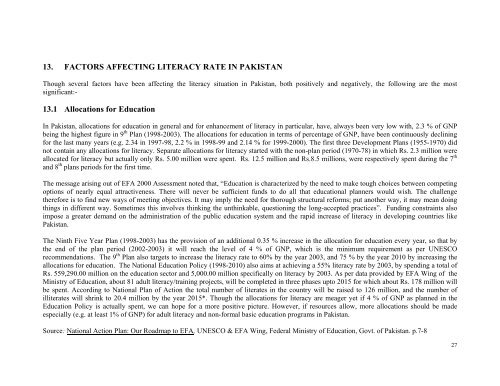Literacy Trends in Pakistan - UNESCO Islamabad
Literacy Trends in Pakistan - UNESCO Islamabad
Literacy Trends in Pakistan - UNESCO Islamabad
Create successful ePaper yourself
Turn your PDF publications into a flip-book with our unique Google optimized e-Paper software.
13. FACTORS AFFECTING LITERACY RATE IN PAKISTANThough several factors have been affect<strong>in</strong>g the literacy situation <strong>in</strong> <strong>Pakistan</strong>, both positively and negatively, the follow<strong>in</strong>g are the mostsignificant:-13.1 Allocations for EducationIn <strong>Pakistan</strong>, allocations for education <strong>in</strong> general and for enhancement of literacy <strong>in</strong> particular, have, always been very low with, 2.3 % of GNPbe<strong>in</strong>g the highest figure <strong>in</strong> 9 th Plan (1998-2003). The allocations for education <strong>in</strong> terms of percentage of GNP, have been cont<strong>in</strong>uously decl<strong>in</strong><strong>in</strong>gfor the last many years (e.g. 2.34 <strong>in</strong> 1997-98, 2.2 % <strong>in</strong> 1998-99 and 2.14 % for 1999-2000). The first three Development Plans (1955-1970) didnot conta<strong>in</strong> any allocations for literacy. Separate allocations for literacy started with the non-plan period (1970-78) <strong>in</strong> which Rs. 2.3 million wereallocated for literacy but actually only Rs. 5.00 million were spent. Rs. 12.5 million and Rs.8.5 millions, were respectively spent dur<strong>in</strong>g the 7 thand 8 th plans periods for the first time.The message aris<strong>in</strong>g out of EFA 2000 Assessment noted that, “Education is characterized by the need to make tough choices between compet<strong>in</strong>goptions of nearly equal attractiveness. There will never be sufficient funds to do all that educational planners would wish. The challengetherefore is to f<strong>in</strong>d new ways of meet<strong>in</strong>g objectives. It may imply the need for thorough structural reforms; put another way, it may mean do<strong>in</strong>gth<strong>in</strong>gs <strong>in</strong> different way. Sometimes this <strong>in</strong>volves th<strong>in</strong>k<strong>in</strong>g the unth<strong>in</strong>kable, question<strong>in</strong>g the long-accepted practices”. Fund<strong>in</strong>g constra<strong>in</strong>ts alsoimpose a greater demand on the adm<strong>in</strong>istration of the public education system and the rapid <strong>in</strong>crease of literacy <strong>in</strong> develop<strong>in</strong>g countries like<strong>Pakistan</strong>.The N<strong>in</strong>th Five Year Plan (1998-2003) has the provision of an additional 0.35 % <strong>in</strong>crease <strong>in</strong> the allocation for education every year, so that bythe end of the plan period (2002-2003) it will reach the level of 4 % of GNP, which is the m<strong>in</strong>imum requirement as per <strong>UNESCO</strong>recommendations. The 9 th Plan also targets to <strong>in</strong>crease the literacy rate to 60% by the year 2003, and 75 % by the year 2010 by <strong>in</strong>creas<strong>in</strong>g theallocations for education. The National Education Policy (1998-2010) also aims at achiev<strong>in</strong>g a 55% literacy rate by 2003, by spend<strong>in</strong>g a total ofRs. 559,290.00 million on the education sector and 5,000.00 million specifically on literacy by 2003. As per data provided by EFA W<strong>in</strong>g of theM<strong>in</strong>istry of Education, about 81 adult literacy/tra<strong>in</strong><strong>in</strong>g projects, will be completed <strong>in</strong> three phases upto 2015 for which about Rs. 178 million willbe spent. Accord<strong>in</strong>g to National Plan of Action the total number of literates <strong>in</strong> the country will be raised to 126 million, and the number ofilliterates will shr<strong>in</strong>k to 20.4 million by the year 2015*. Though the allocations for literacy are meager yet if 4 % of GNP as planned <strong>in</strong> theEducation Policy is actually spent, we can hope for a more positive picture. However, if resources allow, more allocations should be madeespecially (e.g. at least 1% of GNP) for adult literacy and non-formal basic education programs <strong>in</strong> <strong>Pakistan</strong>.Source: National Action Plan: Our Roadmap to EFA, <strong>UNESCO</strong> & EFA W<strong>in</strong>g, Federal M<strong>in</strong>istry of Education, Govt. of <strong>Pakistan</strong>. p.7-827
















